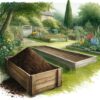Breathe New Life into Your Old Tools Refurbish and Waterproof Your Garden Tool Handles
Renew your wood handle tools
We all have gardening tools that have been left out, and show the wear that the harsh gardening environment can create. Your trusty garden tools have seen countless seasons, enduring sun, rain, and the wear and tear of constant use. While their blades and heads may still be sharp, the wooden handles might show signs of age. But don’t be quick to toss them away! With a little TLC, you can easily restore your tools to their former glory, extending their life and saving you money.
Why Refurbish?
Restoring your garden tool handles is not just a cost-effective move; it’s a journey into the heart of true craftsmanship. When you refurbish your tools, you’re engaging in an age-old tradition of caring for and respecting the tools that help you create and maintain beauty in your garden. The benefits of this process are numerous and impactful:
- Save Money – Avoid buying new tools and extend the lifespan of your existing ones. This not only saves your wallet but also teaches the invaluable lesson of resourcefulness and sustainability.
- Increase Durability – Waterproofing protects the wood from moisture damage, preventing cracks and rot. This process ensures that your tools can withstand the test of time and the elements.
- Improve Grip – Smooth and refreshed handles provide better grip and control. This improvement in ergonomics can make your gardening tasks easier and more enjoyable.
- Boost Aesthetics – Restored tools look great and add a touch of charm to your garden shed. They become not just tools, but pieces of art that reflect your dedication to your garden.
- Reduce Waste – By reusing and restoring tools, you contribute to a more sustainable lifestyle. This act is a small but significant step towards a more eco-friendly world.
DIY Refurbishing & Waterproofing Guide
Embarking on the journey of refurbishing and waterproofing your garden tool handles is both rewarding and enjoyable, but also simple and requires very few items or skills. Here’s what you’ll need and the steps to follow to ensure success:
Materials Needed
- Sandpaper (various grits) or sanding sponge
- Steel wool
- Natural oil (tung oil, linseed oil, etc.)
- Rags
- Optional: paint, varnish, or stain
Step 1 – Clean and Assess
Before diving into the refurbishing process, it’s crucial to prepare your tools properly. This initial step sets the foundation for a successful restoration:
- Remove dirt and grime with soapy water and a scrub brush.
- Let the handles dry completely.
- Inspect for cracks and damage. Minor cracks can be repaired with wood filler.
Step 2 – Sanding
Sanding is more than just a preparatory step; it’s an opportunity to connect with your tool and understand its structure and composition:
- Start with rough sandpaper to remove any loose wood and smooth rough surfaces.
- Gradually move to finer grits for a polished finish.
- Be careful not to sand too aggressively, as this can alter the shape of the handle.
Master Gardener Tip: I like to use sanding sponges for this task, it conforms to the round shape and makes short work of evenly sanding the garden tool surface.
Step 3 – Apply Oil
Choosing and applying the right oil is a crucial part of the process. It’s not just about protection; it’s about nourishing the wood and bringing out its natural beauty:
- Choose a natural oil suitable for outdoor wood.
- Apply a generous amount of oil with a rag, working it into the wood.
- Allow the oil to soak in for several hours before applying additional coats.
- Repeat the process until the wood is saturated and feels smooth.
Step 4 – Optional Finishing Touches
The final touches are where your creativity can shine. This step is about personalizing your tools and making them truly your own:
- Once the oil has dried completely, you can paint, varnish, or stain the handles for added color and protection.
- Consider adding a decorative touch with stencils or hand-painted designs.
Warning!! Boiled linseed oil can spontaneously combust...I have had it happen several times. Make sure if you use a rag to apply it, wash it out and spread it to dry on a flat surface outside. If you crumple it up, the heat generated and contained as the oil is oxidized.
Tips for Success
To ensure the best results, keep these tips in mind as you work on your tools:
- Work in a well-ventilated area and wear gloves and a mask when sanding.
- Use a soft, lint-free cloth for applying oil.
- Avoid using harsh chemicals or cleaners, as they can damage the wood.
- Reapply oil regularly, especially at the start of the gardening season or after prolonged exposure to moisture.
Enjoy Your Renewed Tools!
By following these simple steps, you can easily restore your garden tools to their original condition, ensuring they remain reliable companions for years to come. Not only will you save money and reduce waste, but you’ll also enjoy the satisfaction of giving your favorite tools a new lease on life. So grab your sandpaper, oil, and a little elbow grease, and let the revitalization begin!










